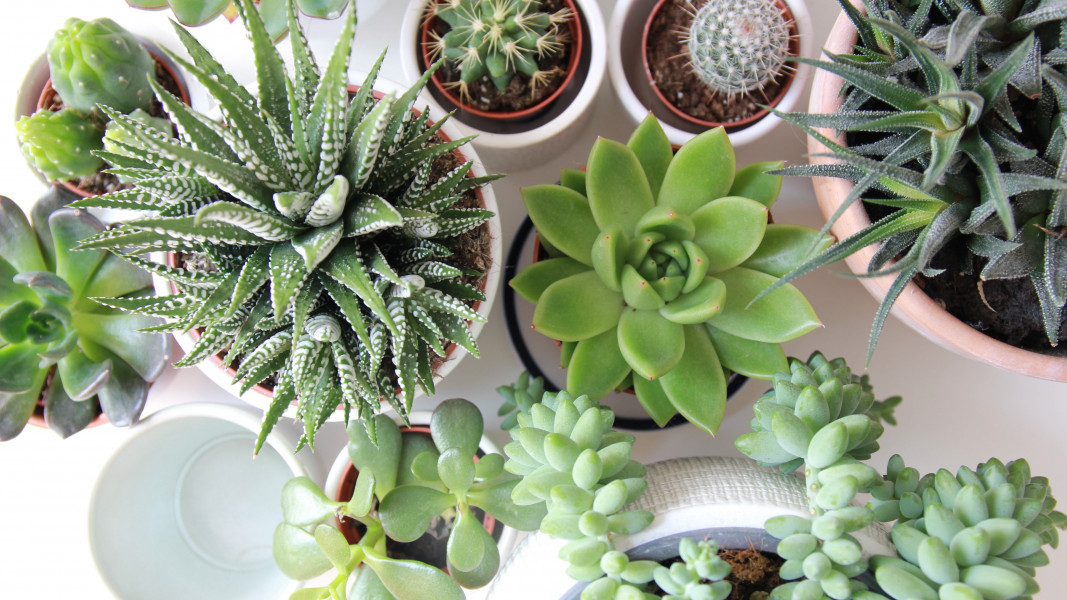A Brief Guide to Succulents
Succulent plants are perennial plants that are characterized by fleshy, juicy leaves that retain moisture for a long time, so they have little need for irrigation. The word "succulent" comes from the Latin word “sucus”, meaning "something juicy." Cacti are also a type of succulent plants with modified leaves that have turned into spines so that the plant can adapt to harsh living conditions - lots of sun, little humidity, large temperature amplitudes and protection from pests or herbivores in the desert / the semi-desert territories.
Over 800 species of succulents are known and the most common among them are cacti. However, indoor succulents are also used for medicinal purposes. Such are aloe, the traditional kalanchoe, medicinal agave and others. Two types of succulents differ in the way they accumulate moisture: leaf and stem succulents. The former have thick, liquid-accumulating leaves and have a unique wax coating, and the latter are able to accumulate moisture in their stems, and their root system is able to accumulate moisture even from the surface of the soil.
Here are some basic tips on how to care for your favorite succulent plants:
SHOW CARE & LOVE
Grow your plants with love and be sure they will feel it.
LIGHT
Succulent plants with non-green stems and leaves, mossy or covered with a gray-blue waxy or powdery coating need a lot of light, while pale green "naked" plants can grow in the shade.
WATERING
Summer - 5-7 days
Spring and autumn - at 10 days
Winter - at 30 days or without watering
These plants are adapted for economical use of water. It is recommended not to water with more than 4-6 ounces. water and wait for the soil to dry out between waterings.
TEMPERATURE
The majority of succulents favor warm climates. Throughout the winter, they go into dormancy. Succulents typically overwinter below a temperature of about 60ºF.
TRANSPLANTATION
It is done rarely, every 2-3 years. Succulent plants are transplanted into a slightly larger pot, only in spring and summer. When transplanting, succulents are not watered. Use shallow rather than deep pots. You can see our short video material with some easy steps and tips for transplanting this type of plant.
SOIL
Succulents are grown in sandy compost that allows excess water to drain. The suitable soil for them mainly contains small pebbles, coarse sand, peat or forest soil. They are fed with organic fertilizers, but not all plants - mainly those with faster growth and in spring and summer.
MULTIPLICATION
The leaves of the succulent plants or the so-called cuttings root easily on the surface of suitable soil. For this purpose, you can use leaf cuttings, which are nice to separate from the plant in spring or summer. They are then allowed to dry for several days before being laid on the surface of the soil substrate. They are watered very sparingly and are not covered. If you decide to sow seeds, they generally germinate at a temperature of Between 70ºF - 77ºF.
Among these plants there are also flowering species, and this process usually occurs during the summer months or early autumn.
The most famous succulents, however, remain cacti. Almost all cacti are succulent plants, but although they have similar characteristics and are grown in the same way as other succulents, they have their own specifics and peculiarities in terms of care.
7 Tips When Growing Succulents
Succulents are easy plants to grow because they are not capricious and do not keep you constantly fussing around them. In addition, they have recently become one of the most preferred plants that contribute to a modern interior. Check out 7 tips when growing succulents:
- Adaptation - Succulents are relatively adaptable plants and are believed to be able to thrive in 3 possible environments - desert climate (warm and dry), mountainous region (cold and frosty), tropics (wet and salty).
- Flowering - it is a myth that succulents do not flower. Many species have beautiful flowers in pink, red, and yellow. However, the fact is that you have to be very patient.
- Nutrition - succulents do not need special nutrition, because in addition to water, they have the ability to stock up on useful substances. For some types of fertilization, once a year is quite enough.
- Drainage - it is important to provide good drainage for succulents to prevent root rot and water retention. At the bottom of the pots put pebbles.
- Orient yourself by the leaves - from there you can find out what your succulent plant needs. The thicker the leaves, the less water you need to use for the next watering. Brown tips are a signal of too much light, and when they don't grow densely, you need to provide them with more sun. Fallen leaves may be caused by a change of location, overwatering, lack of light or large temperature amplitudes.
- For succulents coming from the tropics, it is necessary to maintain high humidity, and the temperature regime during the winter break should be around 60ºF. But for succulents coming from hot latitudes, a minimum of 60ºF should be ensured during their wintering. They need moderate watering in the summer.
- If the color of the plants is red or light, they should be provided with as bright lighting as possible. On the other hand, dark colored plants should be kept away from bright light.

